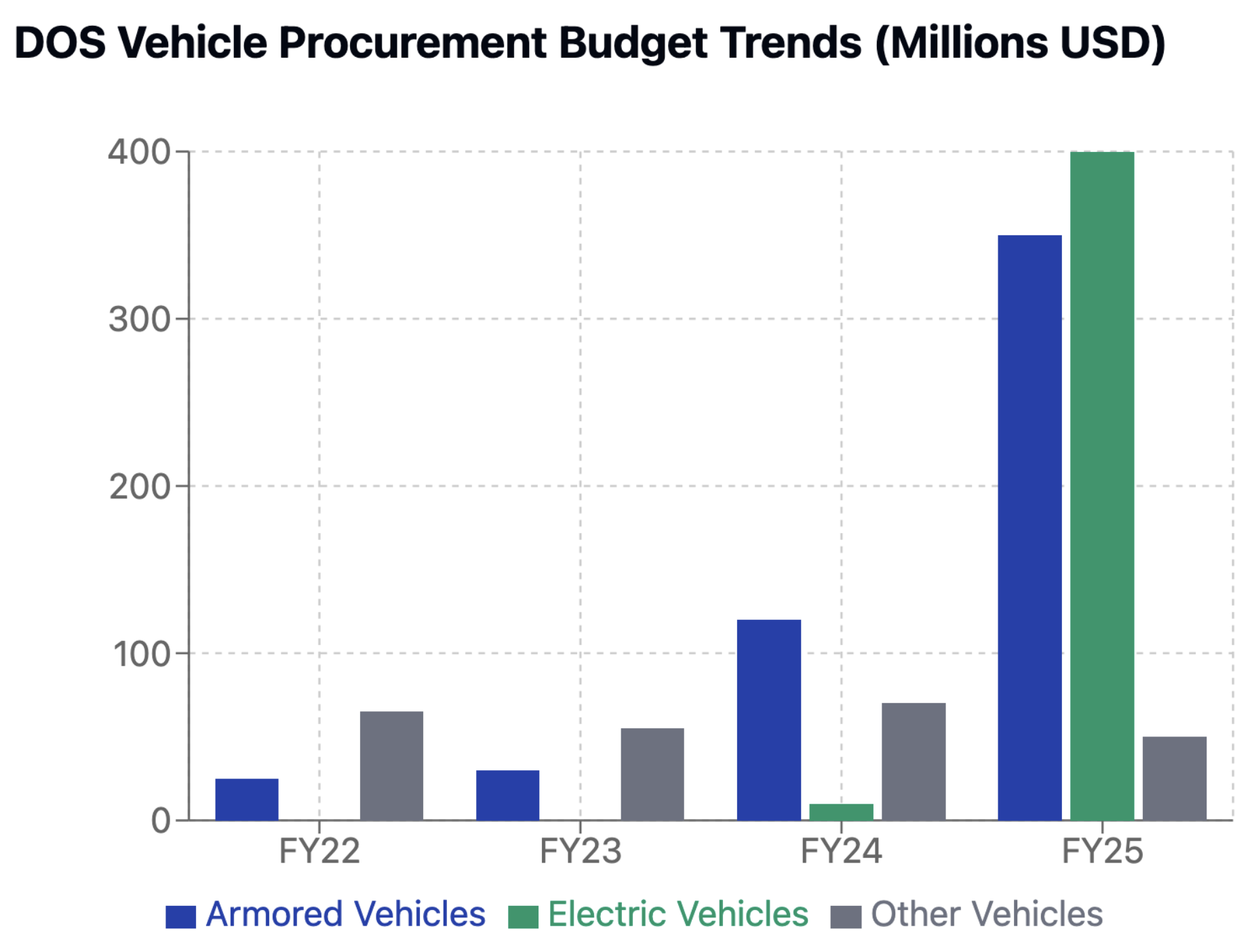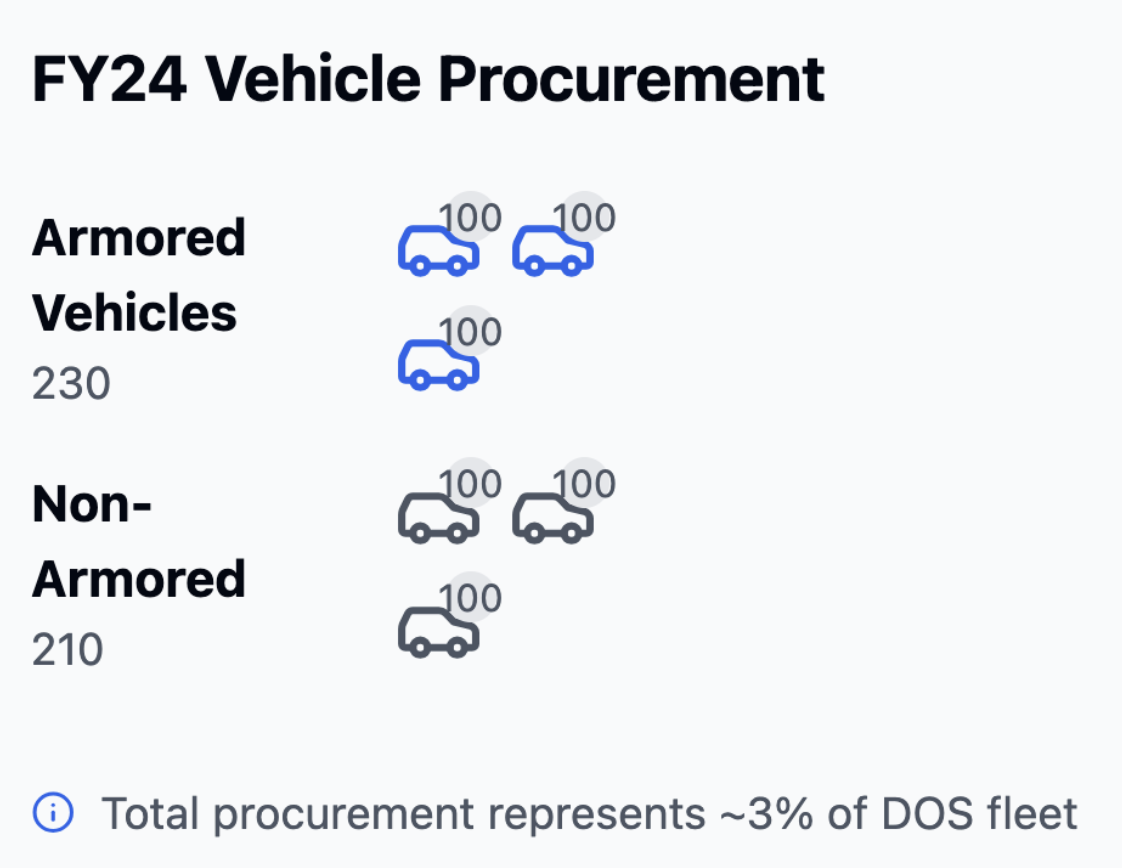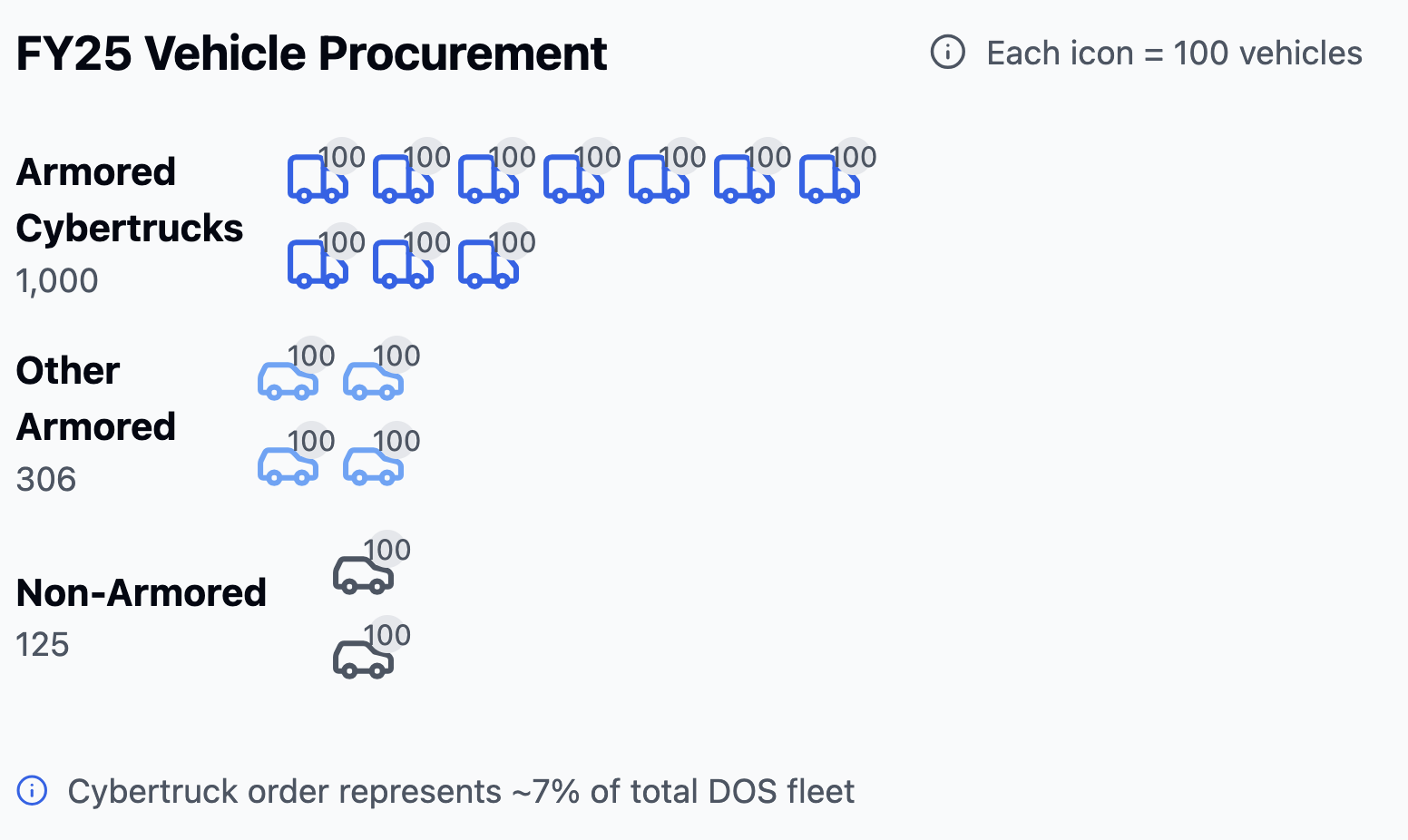A $400 Million Tesla Purchase: Analyzing the State Department's Procurement Plan
February 2025
The U.S. State Department's DoS needs armored vehicles to safely transport diplomats, officials, and VIP visitors in high-threat environments where they might be targeted by terrorists, hostile state actors, or criminal organizations - particularly in regions where U.S. personnel are high-value targets. Every U.S. embassy and consulate (there are roughly 275 diplomatic posts worldwide) requires multiple vehicles for daily operations, security details, and emergency evacuation capabilities. recently disclosed plan to allocate $400 million for armored Teslas in its 2025 procurement forecast raised enough eyebrows that it made the news. Initially, the forecast named Tesla explicitly, before hasty edits transformed it into a more generic "Armored Electric Vehicles" entry, presumably to avoid political entanglements.
This caused the predictable outrage and accusations of graft spread over social media. I found myself having a kitchen conversation with a friend where I ended up playing my usual contrarian role: How weird is this really? Do we have a sense of the numbers? Is this an actual problem or just mud-slinging?
This mostly stems from my not trusting headlines very far. See The media never lies but the truth they speak may not be the truth you hear. Clearly, the headline is supposed to drive you to the conclusion that there is graft and foul play. I decided to do some basic legwork I'm always advocating doing the legwork and going to primary sources. I do try to practice what I preach, but it's also time-consuming. I was curious how much faster it can go now with LLMs. and see how well that fit.
Initial Investigation
I started with a quick chat with ChatGPT. What I quickly discovered was that the LLM pretty much only knew what was being reported by the news, mostly only the headlines, and couldn't get me any other information, even when explicitly told to search for it. When asked what last year's budget included for vehicles, it said that this info was "hard to find and not specific."
That led me to the next question: how did this procurement forecast even end up becoming public? Was it a leak? Was someone trying to make a political objection? Is it typically published? Turns out that it's published every year, and they are all conveniently in one place. This is exactly the sort of source documents that I'm looking for!
Hypothesis First
I wanted to start with a few hypotheses before I dug into the data. I came up with four hypotheses, each one I wanted to disprove:
1. Graft – In this case, I'm talking about soft graft. I'm reasonably sure that if the DoS buys Cybertrucks, the trucks will actually be delivered. But we also know that Tesla has been having trouble selling Cybertrucks and has a lot of backed-up capacity and inventory. Did Musk just push the buy button to give his own company a juicy government contract? This might include explicit soft coordination in the style of the famous "Will no one rid me of this turbulent priest?" incident.
2. Business as Usual / Pent-Up Demand – I don't really have a sense of how much the State Department would be expected to spend on vehicles in a year. Is $400M unusually large? Did the fleet need an upgrade?
3. Bureaucratic Favor-Seeking – Maybe someone in the State Department saw this as a career-boosting move, or just a way to curry favor for the whole department. I'm not entirely sure how we can distinguish this from graft, and it would be troubling even on its own.
4. Policy Reversal – The previous administration was pretty clearly hostile to Tesla. They might have been blocking them from government contracts. Maybe this is what the DoS really wanted, and now they can finally get it.
Testing the Hypotheses
To test these hypotheses, we need counterfactuals:
If this is not graft, we would see the budget being pretty much in line with previous budgets. If we have indications that this was in the works before the election, that's another strong indication it's not graft. If this is attached to some large existing program or set of changes, I think that would also support a "not graft" idea. We have a red flag already because it's pretty weird for the vendor to be specifically named in the planning document, indicating a lack of bidding process. How typical is that?
If this is not business as usual, we would see a large difference in the amount spent. Other indications that it was a problem would be if it were introduced suddenly after Elon got involved. If this involves a pivot from trends in vehicle purchases, that would also be a red flag. For instance, has the DoS been trending toward buying more smaller vehicles? Or trying to buy local in other countries? Any communication from Elon would pretty much be a smoking gun.
If this is not bureaucratic favor-seeking, there is solid overlap with the "not graft" counterfactuals. To distinguish between graft and brown-nosing, we would need to look for either documentation or whistleblowing of orders, or suggestions... or the inverse, documentation of someone saying this is a good way to curry favor. There is a weaker distinguisher of looking to see if the DoS has a pattern of trying to buy influence as a side benefit in its purchasing.
If this is not policy reversal on a Tesla boycott, we would find previous Tesla purchases by the DoS. Or we might find that this is not the style of vehicle they have been trending toward, even from other vendors. It's also worth checking if there are any other vehicles in this category.
Digging into the Numbers: What the Past Forecasts Say
At this point, I pulled the 2022, 2023, 2024, and current (2025) procurement forecasts. They were huge, so I decided to try feeding them through an LLM to see what could be pulled out. Deepseek pretty much spun out and died when I did this. I moved on to Claude Sonnet which, on its own, decided to write a script to search the documents for relevant lines and then work with the output. I'm impressed.

First thing worth noting is that we clearly have a massive jump in vehicle spending. Big enough that we can rule out "business as usual" though not necessarily "pent-up demand", but that would be a LOT of pent-up demand. If I wanted to really run this to ground, I would start looking for indications of an aging fleet.
The trend toward armored vehicles was visible, and it does seem like this purchase almost looks reasonable with that. There also was a gesture of a movement toward electric vehicles.
Another thing that leaps out at me is that spending on other vehicles didn't actually go down by very much. That's a little bit of a flag for me, as it indicates that the Tesla order was in addition to rather than displacing other purchases. That hints to me that we are not looking at "business as usual" or "pent-up demand."
The Numbers in Context
Let's do a little back-of-the-envelope math on this... how many Cybertrucks are we talking about buying here? A high-end Cybertruck runs around $100k. Claude suggested that adding diplomatic armoring to a vehicle costs around $300k over base price, and that the Cybertruck's "armoring" might be helpful but at best could pull that down by $100k.
So we are talking about $300k each. If we put some overhead for infrastructure on top of that, we end up with about 1,000 Cybertrucks. That's a lot, and helpful for context.

A quick search showed me a 2012 document indicating a DoS fleet size of about 14,000. I don't have a sense of how much this would have grown, but it doesn't feel crazy to me to leave it at that number, and I don't think it's worth the time to run it to ground.

For additional context, let's look at how much money this is relative to the involved entities:
The whole DoS budget is around $63 billion, which puts this Cybertruck purchase at something like 0.5% - 1%. That's actually kind of meaningful.
Tesla sells about $77 billion in vehicles annually. Even if we assume that they are doing the armoring in-house and getting paid for it, that would be at best about 0.5% of the gross for the year. More realistically, they are probably not doing the armoring in-house, so we would be looking at more like 0.2% of gross.
To me, this runs against the "graft" narrative. The numbers are just too small to move the needle for Tesla, though it might make sense if it's part of a government-wide push to "buy Tesla."
The Article Analysis
After running these numbers, I finally read the Guardian article. A few things caught my eye:
Musk wrote: "I'm pretty sure Tesla isn't getting $400m. No one mentioned it to me, at least."
Well, at this point I really only think Musk's comments are useful for trying to figure out what direction he's pointed in. I don't think they have any particular alignment with the truth.
The government spokesperson said the previous administration under Joe Biden had put out a request for armored electric vehicles, but only one unnamed company had responded.
I'm curious who that was. A little googling shows that Xos is shipping Armored Electric Vehicles (AEVs) in the scale of like low hundreds. INKAS has some out for pre-order as well, but doesn't seem like they could ship those numbers.
It's also possible that the responding company was Tesla, which would line up nicely with the "boycott lifted" narrative. I can create a narrative that goes "Biden's admin was asking for AEVs, the only bidder was Tesla, we weren't buying Teslas so we didn't buy them, now the requisition is still there so we are taking the bidder". I don't put too much faith in that narrative though, it's very "just so".
The department website contains two versions of the forecast document. The first showed the Tesla planned procurement, entered on 13 December 2024, according to the document. That was a month after Trump's election, but before he took office.
That date pretty much indicates to me that if it's graft it would need to be "soft coordination". At this point, we would need to go through Musk's Twitter posts from before then and look for some sort of dog-whistle order to buy Tesla. I honestly don't have the energy, but I'm assuming I would have heard about it? This doesn't preclude brown-nosing though.
Additional Context from Drop Site News
The original story was broken by Drop Site News, and their article provided some interesting additional context:
According to the State Department, only a single company responded to last year's request for information—Tesla—and there are currently no plans for the award to continue. The State Department stated that the next step in the process would involve "an official solicitation [being] sent out to vehicle manufacturers to bid," adding that "However, the solicitation is on hold and there are no current plans to issue it."
This confirms that Tesla was indeed that unnamed bidder. That could also explain why Tesla was initially specified on the procurement document.
The article also links to an RFI, which has three interesting points:
First, we get a hint on the timeline:
"Responses are requested in searchable Microsoft Windows-compatible format (i.e. .doc, .pdf, etc.) by 2:00 PM local time May 20, 2024. No page limit."
I don't know when the RFI went out, but we have to assume that it gave plenty of time for responses. That puts these events well before the election.
second we see the requirement that
"Be adequately equipped to blend into overseas surroundings for everyday traffic based on mission requirements"

Tee hee hee
Finally, we get some interesting fleet information:
"Currently, DEAV has a deployed AV fleet of over 3,000 armored vehicles and an additional several hundred AVs in production."
That puts the 1,000 Cybertrucks in perspective - it would be a significant fleet expansion.
Conclusion: Which Hypothesis Breaks?
It's pretty clearly not business as usual. The numbers moved by too much. There is a pretty sudden jump.
It's also pretty clearly not graft. We have requisitions indicating that they were going to try to do this going back to well before the accused administration was in power. We also know that Tesla was the ONLY respondent.
We see why they would be requisitioning Teslas specifically, since they were the only bidder, but the remaining question is "why so many?"
It might be brown-nosing, or some similar sort of move. Maybe someone just thought they could get away with expanding their budget since it was "Tesla" and the head of DOGE would be less inclined to be hostile to it. Or maybe they thought it could actually help them get more leverage with Musk.
It might be pent-up demand or a ramp-up - it seems like they were planning to buy a bunch of AEVs going back at least a while. From 2023 to 2024 we saw armored vehicle spending increase about 4x. It's not totally crazy for 2024 to 2025 to see it 3x again. It's still a little startling, particularly given the existing fleet size of 3,000.